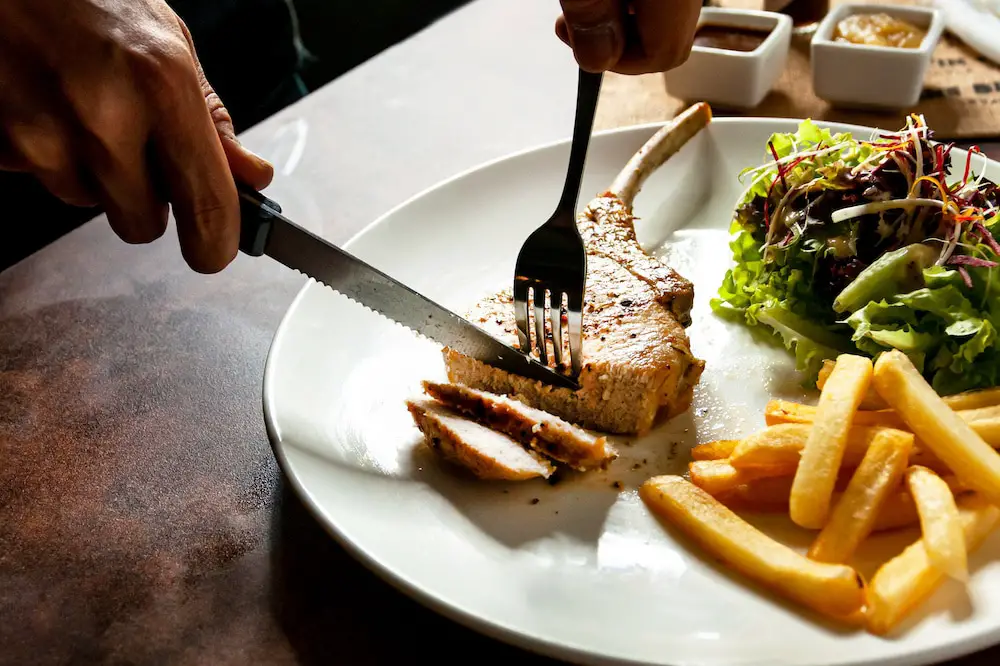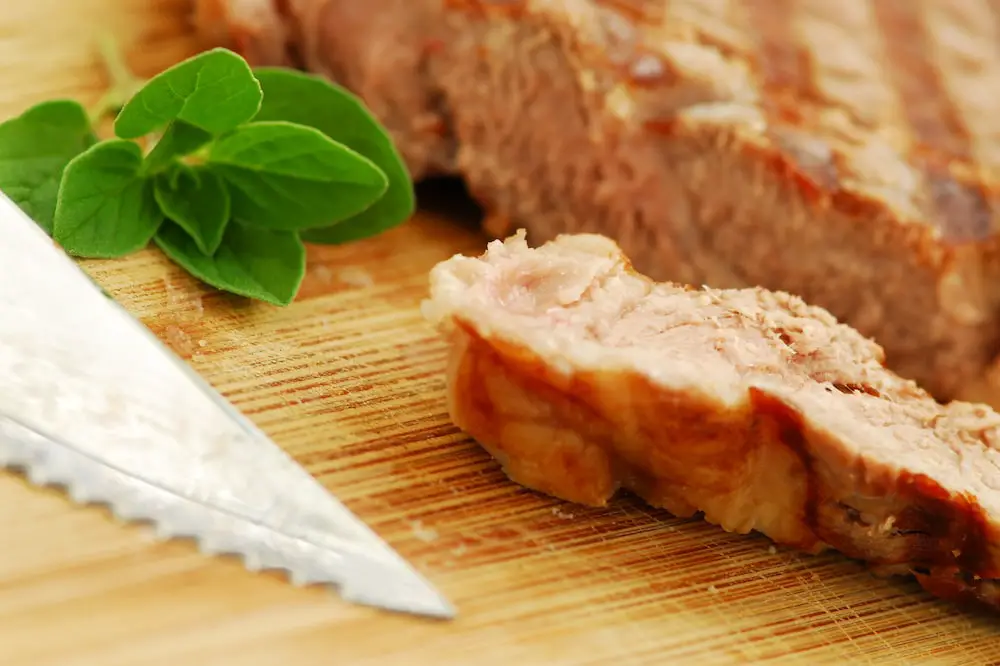Steak knives are an essential addition to any knife collection.
Not only do they let you enjoy a well-prepared steak easily but also ensure you don’t lose the meat’s flavorful juices.
Are you curious to know why are steak knives serrated?
Today, we’ll talk all about these handy kitchen knives to help you understand why they are designed the way they are.
Why Do Knives Have Different Cutting Edges?
When we think about steak knives, we often think of a jagged, teeth-like edge that makes it easier to cut through the tough exterior of food.
However, if you think about it, steak knives are not the only ones with serrated blades; you can also find them in bread knives.
So, why do these knives have serrated edges?
Unlike a smooth blade edge, knives with a jagged edge allow you to slice through the food’s tough exterior without ruining its entire shape.
The uneven edge works like a saw, making it possible to do a smooth cut on items with a soft interior.
Keep in mind that using a serrated knife requires skill, as you may tear the item if you fail to position the blade correctly.
Why Are Steak Knives Serrated?
To understand why are steak knives serrated, let’s talk about key points that make them unique.
Design
As its name implies, a serrated steak knife comes with a teeth-like edge where you will find gullets in between every other two teeth.
Though some may think these serrations are random, each tooth on the knife’s edge has specific angles and sizes to enhance performance.
These serrated steak knives have narrow gullets while having pointed angles similar to a knife’s tip.
Performance
In case you don’t know, the most solid and powerful part of any knife is its pointed tip.
Because a serrated steak knife comes with numerous tiny pointed tips, you’ll find it easier to slice through the meat.
Sharpening
Straight-edged knives have a more straightforward sharpening process than their jagged and pointy counterparts.
As you can imagine, it is not as easy with serrated knives because they don’t have an equal angle.
If you sharpen a serrated blade following the same method you use when sharpening a straight-edge knife, you’ll only be damaging its jagged edge.
You need to sharpen each gullet separately using a thin conical file, which will technically hone the edges instead.
Honing is different from sharpening as it only polishes the surface by removing the irregularities, slightly improving the cutting motion.
Hence, it is better to leave the sharpening of steak knives to professionals to get better results.
The most common sharpening tool used for a serrated blade is a ceramic sharpening rod, which hones the knife rather than sharpens it.
We don’t recommend using electric knife sharpeners as they may damage the cutting edge due to the preset angles of the blade.
On the other hand, whetstones are primarily for the straight edges of the steak knife.
Fortunately, serrated knives do not require sharpening as frequently as straight-edged ones.

Are All Steak Knives Serrated?
When you go out looking for a set of quality steak knives, you’ll quickly realize that they come in many styles and sizes.
In fact, contrary to popular belief, even their cutting edge comes in different styles.
You’ll find both serrated and non-serrated steak knives you can choose from based on your preference.
The majority look at steak knives with jagged edges as better because of their better edge retention and cutting power.
However, although that is partly true, these blade types are harder to sharpen.
Often, you may have to call a professional to help you get the edge back to its original glory.
Are Non-Serrated Steak Knives Any Good?
Straight-edge or non-serrated steak knives have razor-sharp edges that slice through cooked meats without breaking the fibers.
If you use this tool, you will get a smoother and cleaner slice.
Most steak lovers prefer these cuts because all the flavorful juices from the meat are kept intact.
When using a straight-edge knife, the only problem you will encounter is the frequent sharpening required to maintain its excellent performance.
Fortunately, this type of steak knife is more straightforward to sharpen than its serrated counterpart.
However, you need to know the knife’s specifications to get better results.
Design
Non-serrated steak knives come with straight and sharp edges that cut through the meat smoothly.
Some of these knives have dimples or Granton edges, which are shallow dents placed above the blade’s edge.
Dimpled steak knives have excellent flexibility and maneuverability.
Basically, you’d be able to cut cooked steaks without the meat sticking to the blade’s surface.
Performance
When it comes to performance, non-serrated knives are not as powerful as jagged blades when used on steaks.
Nevertheless, they have sharp blades that can make smooth and accurate slices in delicate foods.
You can use straight-edged knives with tender meat and steak.
Edge Retention
Plain edge knives hit the plate with their full blades, dulling the edges when used constantly.
This is the reason why they require more frequent sharpening than their serrated counterpart.
Sharpening
You follow the same sharpening process for a regular, plain blade when sharpening a straight-edged steak knife.
The challenge is learning how to do it properly using the correct sharpening tools to restore the blade’s original sharp state.
The most common tools would be whetstones and sharpening rods.
Refrain from using electric knife sharpeners, as they may only damage the edge of your knife.
Typically, electric knife sharpeners come with preset sharpening slots and angles that usually take off more metal than needed.
Should You Buy Serrated or Non-Serrated Steak Knives?
To sum up, you use a serrated steak knife to slice through tough meats, while non-serrated ones are for tender cuts.
In the end, it’s up to you to decide which is the better choice between serrated and non-serrated steak knives.
If we are to decide, we’d rather have a complete set of each type.
After all, the more important part is that you pick a set that can last many years.
Though they may come with a higher price tag, you can trust they will perform much better than cheap steak knives.

